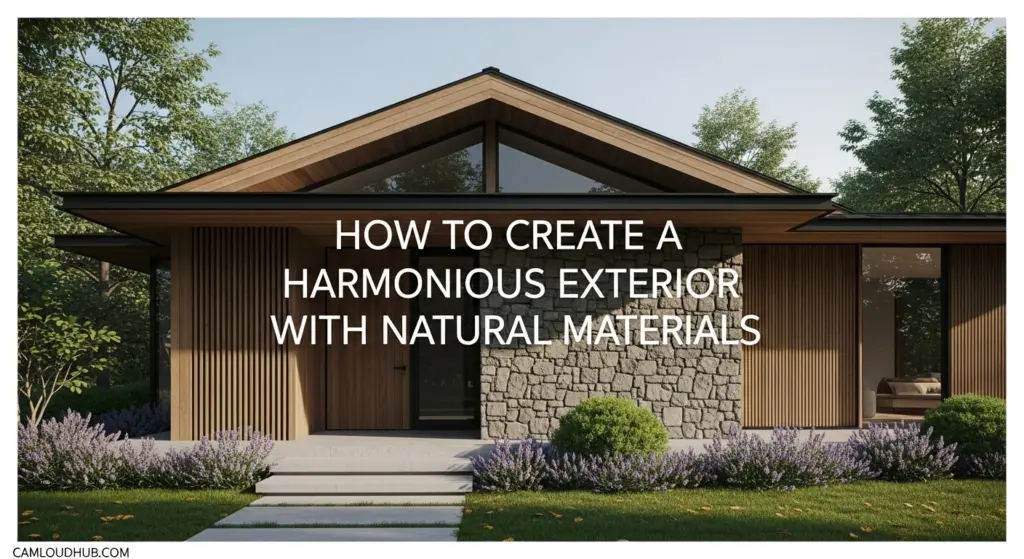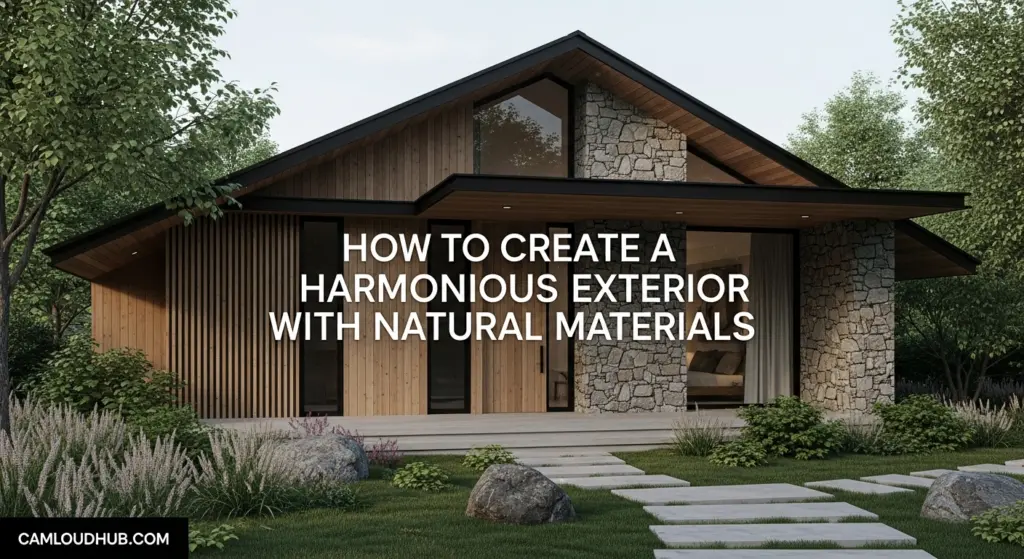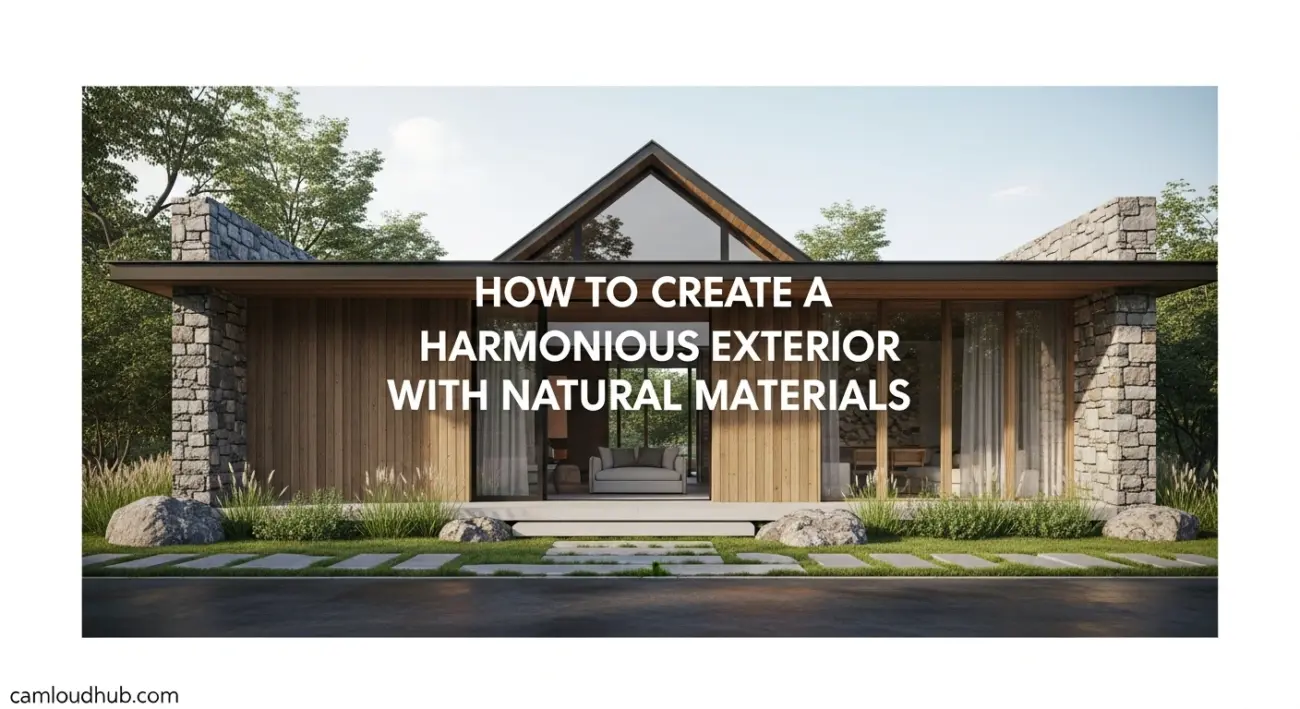Understanding the Appeal of Natural Exterior Materials
How to Create a Harmonious Exterior with Natural Materials – The allure of natural exterior materials lies in their innate beauty and connection to the earth. Unlike synthetic alternatives, they possess unique textures, colors, and patterns that add character and depth to your home’s façade. Beyond aesthetics, these materials often offer superior durability and longevity, making them a worthwhile investment in the long run. Let’s explore why choosing nature-derived options elevates your home’s appearance and sustainability credentials. This section will deep dive into the benefits and appeal of natural exterior materials.

Exploring Popular Natural Exterior Material Ideas
Wood: A Timeless and Versatile Choice
Wood continues to be a popular choice for exterior cladding, decking, and accents. Its natural warmth and beauty create a welcoming atmosphere, while its versatility allows for various design styles. From rustic cedar siding to sleek bamboo decking, wood can be adapted to suit any architectural aesthetic. However, selecting the right type of wood and providing proper maintenance are crucial for ensuring its longevity. Considerations like rot resistance are critical with wood.
Wooden exterior structures not only aesthetically delight the eye, but they also have a certain quality of making one feel closer to nature, a feeling one can enjoy every day. Many homeowners have lauded wooden exteriors as being a practical and sustainable choice for their homes, and for good reason. Choosing the right type of wood to build the desired exterior ensures that the structure will be protected against several environmental and climate-related hazards that could lead to the building’s early decay.
Stone: Strength, Durability, and Natural Beauty
Stone is an incredibly durable and visually striking material that adds a sense of permanence and grandeur to any exterior. Available in a wide range of colors, textures, and sizes, stone can be used for cladding, retaining walls, patios, and walkways. Its natural variations create a unique look that complements any architectural style. Stone is a good option if you are looking for something durable. You should keep in mind that it requires professional construction to install it.
Stone exteriors evoke a timeless beauty, and they are a classic choice for buildings that have been around for ages. Using stone exteriors will give one a sense of the past within their present. The building’s aesthetic is thus timeless from every possible stance. Stone exteriors require low maintenance and will protect the structural integrity of the building under any possible circumstances. Natural stone exterior can last for years with minimal upkeep, making it a cost-friendly choice in the long run.
Brick: Classic Charm and Enduring Appeal
Brick, whether reclaimed or new, offers a classic charm and enduring appeal that few other materials can match. Its warm, earthy tones and textured surface add character and depth to any facade. Brick is also a durable and low-maintenance material that can withstand the elements for generations. Different styles exist, giving homeowners choices for unique textures and styles.
Bricks, whether old or new, are known to possess a certain quaint look in them that other materials cannot replace. Brick exteriors are commonly seen in residential buildings. Due to their strength and durability, they are considered very reliable. Brick exterior does not require a lot of heavy-duty treatments or cleaning up. Brick provides a classic and elegant look to a building.
Bamboo: A Sustainable and Renewable Resource
Bamboo is a rapidly renewable resource that offers a sustainable alternative to traditional wood. Its strength, versatility, and attractive appearance make it an ideal choice for decking, fencing, and siding. Bamboo is also naturally resistant to insects and moisture, making it a durable and low-maintenance option for exterior applications. Bamboo is aesthetically pleasing while being ecologically sustainable.
Using bamboo for exteriors is a great way to incorporate a sustainable choice into your building design. Bamboo grows very fast and is eco-friendly. Using bamboo for exterior also reduces costs, being a budget-friendly alternative. Its ability to withstand moisture and weather, coupled with its natural pest resistance, positions bamboo as a leading material for green building.
Thatched Roofing: A Rustic and Charming Option
Thatched roofing is one of the oldest roofing methods known to man. Though it is not commonly employed in today’s society, it still adds a rustic look to a building that few other methods can match. Thatch is made of dried vegetation such as straw, water reed, or rushes. These materials create a unique texture and natural insulation. It is beautiful and adds distinct charm to a building; however, it needs regular maintenance due to its susceptibility to decay and pests.
Thatched roofing creates a strong, bold statement that is hard to ignore. Thatch, consisting of dried natural materials, provides a distinct look and feel that connects a building directly to its natural environment. Its traditional appeal, combined with the building’s eco-friendly qualities, renders the building quite cozy. Nonetheless, the cost of maintaining thatch may pose a problem to its widespread use.
Cork: A Unique and Sustainable Cladding Material
Cork, harvested from the bark of cork oak trees, is a sustainable and versatile material that offers excellent insulation and soundproofing properties. Cork cladding is available in a variety of textures and colors, providing a unique and visually appealing exterior finish. Cork is known for its sustainable properties. Its unique style can turn a building into something very special.
The eco-friendly qualities and the unique appeal of using cork for façade finishes is causing a buzz in the building industry. Cork material, extracted from the bark of the cork oak, is renewable and sustainable. Besides, it has great insulating and sound dampening abilities, making the building more energy efficient and comfortable. Cork cladding provides unique visual styles that will bring a new look to any project.

Living Walls: Bringing Nature to Your Walls
Living walls, also known as green walls or vertical gardens, are a stunning way to incorporate nature into your exterior design. These vertical structures are covered with plants, creating a vibrant and dynamic focal point. Living walls not only enhance the aesthetic appeal of your home but also improve air quality and provide habitat for wildlife. Homeowners can enjoy the beauty and peace of nature when gazing at their green walls.
Adding vertical gardens, or living walls, into the building’s facade transforms the exterior into a riot of green colors and textures. These plantations improve the building’s aesthetic appeal and help purify the air, enhance the building’s insulation, and offer habitats for wildlife. The process involves careful irrigation systems plus plant selection to achieve a thriving vegetative façade. This is an investment in visual delight.
Natural Fiber Composites: Combining Strength and Sustainability
Natural fiber composites are innovative materials made from combining natural fibers, such as hemp or flax, with a resin binder. These composites offer a combination of strength, durability, and sustainability, making them an excellent choice for siding, decking, and other exterior applications. They are an emerging and exciting option in the world of natural materials.
Natural fiber composites represent a major development in the construction industry. By combining fibers with resin binders, the advantages of strength and sustainability are merged. Fiber composites have numerous applications, including siding, decking, and paneling. Such combinations reduce the reliance on exclusively synthetic materials and promotes sustainability and eco-friendliness in both the construction and manufacturing procedures.
Considerations for Choosing Natural Exterior Materials
Climate and Location
The climate and location of your home play a significant role in determining which natural exterior materials are best suited for your project. Consider factors such as rainfall, temperature fluctuations, humidity, and exposure to sunlight when making your selection. Some materials may be more resistant to moisture, while others may be better suited for hot, dry climates.
Depending on the weather and location of your house, there are certain natural materials that will suit your needs better than others. The longevity of your exterior building depends on a number of variables, including rain exposure, varying temperature, and humidity levels. Think about the climate in your area when choosing a material that will work best for you.
Budget and Maintenance
Natural exterior materials vary in price, so it’s essential to establish a budget before starting your project. Also, consider the long-term maintenance requirements of each material. Some materials may require regular sealing or painting, while others are relatively maintenance-free. Balancing cost and maintenance is crucial for making a practical and sustainable choice.
Set a budget before choosing exterior materials, because natural materials have a wide range of pricing points. In addition to prices, note whether any maintenance is required. Some natural materials require regular sealing and repainting to remain in good condition, or they do not require work at all. The materials selected should balance costs and the amount of maintenance that the materials require.
Sustainability and Environmental Impact
When choosing natural exterior materials, prioritize sustainability and minimize your environmental impact. Look for materials that are sourced from responsibly managed forests, recycled or reclaimed, and manufactured with eco-friendly processes. Consider the life cycle of the material, from extraction to disposal, to ensure that it aligns with your sustainability goals.
When looking to implement natural exterior materials, make sure that minimizing your carbon footprint is prioritized. Strive to utilize materials acquired from sustainable managed woods, recycled products, and eco-friendly fabrication. To match your sustainability goals, evaluate a material’s effects from the day its resources were drawn until the day it is discarded.
Designing for Harmony: Integrating Natural Materials into Your Exterior Design
Color Palette and Textures
Creating a harmonious exterior design involves carefully considering the color palette and textures of your chosen materials. Opt for natural colors that complement the surrounding landscape, such as earthy browns, muted greens, and warm grays. Mix and match different textures to add visual interest and depth to your design. How the colors and textures relate to each other will impact the overall feel.
Consider the impact of materials and colors when choosing the perfect exterior look. Choose natural tones, such as earthy browns and grays, or muted greens to complement nearby landscaping. Feel free to mix materials to create depth to the design and to enhance visual interest. Materials create an aesthetic that will impress visitors and guests for years to come.
Landscaping and Planting
Landscaping and planting play a crucial role in integrating natural materials into your exterior design. Choose plants that are native to your region and that complement the colors and textures of your home’s exterior. Incorporate trees, shrubs, and flowers to create a lush and inviting outdoor space. Integrating plants can soften the hard angles of architecture.
Landscaping and plant choices are critical to blending in the exterior of a site with the environment. Select plants that will blend with outside aspects and complement the overall exterior tones and textures. Plant shrubs, flowers, and trees to provide a lush vibe. The blend of different plants can enhance the natural aesthetic of a home or building, further connecting the home to its surrounding nature.
Lighting and Accents
Lighting and accents can enhance the beauty of natural exterior materials and create a welcoming atmosphere. Use warm, inviting lighting to highlight the textures and colors of your chosen materials. Add natural accents such as stone pathways, wooden benches, or water features to complete the look. These accents will illuminate and accentuate the existing features of the home.
Exterior lighting, along with carefully selected accents, brings a certain level of warmth and appeal to natural elements. Use warm lighting to accentuate materials, textures, and colors. Add natural features such as rock paths, wood benches, and water installations to enhance a certain exterior look. These details create a friendly environment and enhance the overall design.
Case Studies: Inspiring Examples of Natural Exterior Design
Rustic Stone Cottage
This charming cottage features a natural stone exterior with a thatched roof, creating a rustic and timeless appeal. The surrounding landscape is filled with wildflowers and native plants, further enhancing the natural beauty of the property. The stone, thatch, and wildflowers blend perfectly together for a storybook aesthetic.
Modern Timber-Clad Home
This contemporary home showcases a sleek timber-clad exterior with large windows that offer stunning views of the surrounding forest. The use of sustainable wood and minimalist design creates a modern and eco-friendly living space. The timber provides a contrasting accent that is both bold and beautiful.
Urban Green Oasis
This urban home features a living wall that covers the entire facade, transforming it into a vibrant green oasis. The living wall not only enhances the aesthetic appeal of the home but also improves air quality and provides habitat for wildlife in the urban environment. The greenery provides a welcome respite from the concrete jungle.
Maintaining Your Natural Exterior Materials
Cleaning and Sealing
Regular cleaning and sealing are essential for protecting your natural exterior materials and maintaining their beauty. Use gentle cleaning solutions and avoid harsh chemicals that can damage the surface. Apply a sealant to wood, stone, and brick to protect them from moisture and prevent staining.
The beauty and the defense of natural exterior materials depend on periodic cleaning and sealing. The use of chemicals in cleaning solutions must be kept to a minimum to prevent damage to surfaces. Apply sealant to stoneworks, wood and brick to resist moisture and to prevent stains. Maintenance will ensure that materials last a long time.
Preventing Rot and Decay
Preventing rot and decay is crucial for ensuring the longevity of wood and other natural materials. Ensure proper ventilation and drainage to prevent moisture buildup. Apply a wood preservative to protect against fungal growth and insect infestation. Regular inspections can help catch problems early.
To extend the lifespan of wood and other natural compounds, it is vital to control decay and rot. Make sure the place is well-ventilated and proper drainage is employed to avert moisture buildup. Protective coatings and regular inspections are important to catch and prevent decay from taking hold. Early treatment can often save a lot of time and money.
Repairing Damage
Addressing damage promptly is essential for preventing further deterioration of your natural exterior materials. Repair cracks in stone or brick, replace damaged wood boards, and re-seal any areas that show signs of wear. Regular maintenance and prompt repairs will help extend the life of your exterior.
To avert further issues with exterior materials, correct problems rapidly. In stonework or brick, repair all splits, replace damaged timbers, and renew coating on damaged regions. Regular checkups and timely repairs help extend the lifespan of buildings, and keep them from undergoing more extensive, and more expensive, repairs.
The Future of Natural Exterior Materials
Innovations in Sustainable Materials
The future of natural exterior materials is bright, with ongoing innovations in sustainable materials and construction techniques. Researchers are constantly developing new and improved materials that are both environmentally friendly and aesthetically pleasing. These innovations pave the way for even more sustainable homes.
With innovations in the process, the future surrounding building with natural materials has much possibility. Exploration is constantly ongoing in the development of materials that are both sustainable and pleasing. These innovative steps offer ways that future homes could be more sustainable.
Green Building Trends
Green building trends are driving the demand for natural exterior materials as homeowners and builders seek to minimize their environmental impact. Energy-efficient design, sustainable materials, and water conservation are becoming increasingly important considerations in the building process. The emphasis on green building will continue to drive sustainable innovation.
The demand for organic exterior products is driven by green construction trends. Due to the emphasis on reducing one’s footprint, factors such as water conservation factors, sustainable materials and efficient design are on the rise in the building industry. Sustainability and innovation is emphasized with green construction and building.

The Growing Emphasis on Biophilic Design
Biophilic design, which seeks to connect people with nature, is becoming increasingly popular in architecture and interior design. Natural exterior materials play a crucial role in creating biophilic homes that promote well-being and enhance the connection to the natural world. Living in a biophilic home can improve overall quality of life.
In architecture and interior design, the approach of Biophilic design is increasingly sought to establish connections between people and the natural world. Natural external materials have a core purpose in the design of homes with Biophilic features that can increase well-being and the connection to the natural world. Access to the natural world makes life better.
Conclusion
Creating a harmonious exterior with natural materials is an investment in both the beauty and sustainability of your home. By carefully considering your climate, budget, and sustainability goals, you can choose the perfect natural exterior material ideas to transform your property into a tranquil haven. Embracing these materials not only enhances your home’s curb appeal but also contributes to a healthier and more sustainable future. Embrace the beauty and practicality of nature in your next exterior project.


